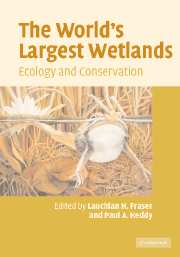Book contents
- Frontmatter
- Contents
- List of contributors
- Preface
- 1 Introduction: big is beautiful
- 2 The West Siberian Lowland
- 3 The Amazon River basin
- 4 The Hudson Bay Lowland
- 5 The Congo River basin
- 6 The Mackenzie River basin
- 7 The Pantanal
- 8 The Mississippi River alluvial plain
- 9 The Lake Chad basin
- 10 The River Nile basin
- 11 The prairie potholes of North America
- 12 The Magellanic moorland
- 13 The future of large wetlands: a global perspective
- Index
- References
3 - The Amazon River basin
Published online by Cambridge University Press: 10 August 2009
- Frontmatter
- Contents
- List of contributors
- Preface
- 1 Introduction: big is beautiful
- 2 The West Siberian Lowland
- 3 The Amazon River basin
- 4 The Hudson Bay Lowland
- 5 The Congo River basin
- 6 The Mackenzie River basin
- 7 The Pantanal
- 8 The Mississippi River alluvial plain
- 9 The Lake Chad basin
- 10 The River Nile basin
- 11 The prairie potholes of North America
- 12 The Magellanic moorland
- 13 The future of large wetlands: a global perspective
- Index
- References
Summary
Introduction
Since the arrival of human beings about 12 000 years ago, wetlands have been favorite colonization areas because of their rich food resources. On Marajó Island at the mouth of the Amazon River and in its lower course, Amerindians built large chiefdoms on elevated places that provided protection against flooding (Roosevelt 1999). They sustainably managed the populations of manatees, river turtles, and other game animals and fish, as evidenced by the first Europeans arriving in Amazonia being deeply impressed by the large numbers of these animals. Acuña (1641) gave detailed information about the use of the aquatic resources of the Amazon River and emphasized the fertility of the floodplain. The vegetation cover was only marginally affected by the Amerindians because they did not raise domestic animals, which would have required deforestation for the preparation of pastures. They grew bananas, manioc, corn, vegetables, fruit trees, and medicinal plants in species-rich home gardens on the levees. In pre-Columbian times, the population density in the Amazon River floodplain was approximately 28 humans per km2 in comparison with 1.2 humans per km2 in the nutrient-poor uplands (mean, 14.6) (Denevan 1976).
After the arrival of the Europeans in 1500, the indigenous population decreased rapidly because of introduced diseases, wars, and slave raidings. Indigenous resource management for subsistence changed to export-oriented exploitation by Europeans, and in a few centuries the previously large populations of turtles and manatees – and later, caimans and otters – were depleted to very low levels.
- Type
- Chapter
- Information
- The World's Largest WetlandsEcology and Conservation, pp. 63 - 117Publisher: Cambridge University PressPrint publication year: 2005



